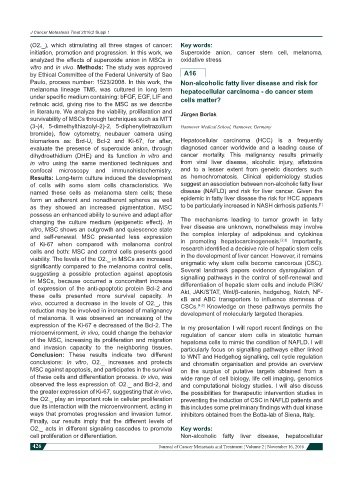Page 436 - Read Online
P. 436
J Cancer Metastasis Treat 2016;2 Suppl 1
(O2._), which stimulating all three stages of cancer: Key words:
initiation, promotion and progression. In this work, we Superoxide anion, cancer stem cell, melanoma,
analyzed the effects of superoxide anion in MSCs in oxidative stress
vitro and in vivo. Methods: The study was approved
by Ethical Committee of the Federal University of Sao A16
Paulo, process number: 1523/2008. In this work, the Non-alcoholic fatty liver disease and risk for
melanoma lineage TM5, was cultured in long term hepatocellular carcinoma - do cancer stem
under specific medium containing: bFGF, EGF, LIF and cells matter?
retinoic acid, giving rise to the MSC as we describe
in literature. We analyze the viability, proliferation and Jürgen Borlak
survivability of MSCs through techniques such as MTT
(3-(4, 5-dimethylthiazolyl-2)-2, 5-diphenyltetrazolium Hannover Medical School, Hannover, Germany
bromide), flow cytometry, neubauer camera using
biomarkers as: Brd-U, Bcl-2 and Ki-67, for after, Hepatocellular carcinoma (HCC) is a frequently
evaluate the presence of superoxide anion, through diagnosed cancer worldwide and a leading cause of
dihydroethidium (DHE) and its function in vitro and cancer mortality. This malignancy results primarily
in vitro using the same mentioned techniques and from viral liver disease, alcoholic injury, aflatoxins
confocal microscopy and immunohistochemistry. and to a lesser extent from genetic disorders such
Results: Long-term culture induced the development as hemochromatosis. Clinical epidemiology studies
of cells with some stem cells characteristics. We suggest an association between non-alcoholic fatty liver
named these cells as melanoma stem cells; these disease (NAFLD) and risk for liver cancer. Given the
form an adherent and nonadherent spheres as well epidemic in fatty liver disease the risk for HCC appears
as they showed an increased pigmentation. MSC to be particularly increased in NASH cirrhosis patients. [1]
possess an enhanced ability to survive and adapt after
changing the culture medium (epigenetic effect). In The mechanisms leading to tumor growth in fatty
vitro, MSC shows an outgrowth and quiescence state liver disease are unknown, nonetheless may involve
and self-renewal. MSC presented less expression the complex interplay of adipokines and cytokines
[2,3]
of Ki-67 when compared with melanoma control in promoting hepatocarcinogenesis. Importantly,
cells and both: MSC and control cells presents good research identified a decisive role of hepatic stem cells
viability. The levels of the O2._ in MSCs are increased in the development of liver cancer. However, it remains
significantly compared to the melanoma control cells, enigmatic why stem cells become cancerous (CSC).
Several landmark papers evidence dysregulation of
suggesting a possible protection against apoptosis signalling pathways in the control of self-renewal and
in MSCs, because occurred a concomitant increase
of expression of the anti-apoptotic protein Bcl-2 and differentiation of hepatic stem cells and include PI3K/
Akt, JAK/STAT, Wnt/β-catenin, hedgehog, Notch, NF-
these cells presented more survival capacity. In κB and ABC transporters to influence stemness of
vivo, occurred a decrease in the levels of O2._, this CSCs. [4,5] Knowledge on these pathways permits the
reduction may be involved in increased of malignancy development of molecularly targeted therapies.
of melanoma. It was observed an increasing of the
expression of the Ki-67 e decreased of the Bcl-2. The In my presentation I will report recent findings on the
microenvironment, in vivo, could change the behavior regulation of cancer stem cells in steatotic human
of the MSC, increasing its proliferation and migration hepatoma cells to mimic the condition of NAFLD. I will
and invasion capacity to the neighboring tissues. particularly focus on signalling pathways either linked
Conclusion: These results indicate two different to WNT and Hedgehog signalling, cell cycle regulation
conclusions: In vitro, O2._ increases and protects and chromatin organisation and provide an overview
MSC against apoptosis, and participates in the survival on the surplus of putative targets obtained from a
of these cells and differentiation process. In vivo, was wide range of cell biology, life cell imaging, genomics
observed the less expression of: O2._ and Bcl-2, and and computational biology studies. I will also discuss
the greater expression of Ki-67, suggesting that in vivo, the possibilities for therapeutic intervention studies in
the O2._ play an important role in cellular proliferation preventing the induction of CSC in NAFLD patients and
due its interaction with the microenvironment, acting in this includes some preliminary findings with dual kinase
ways that promotes progression and invasion tumor. inhibitors obtained from the Botta-lab of Siena, Italy.
Finally, our results imply that the different levels of
O2._ acts in different signaling cascades to promote Key words:
cell proliferation or differentiation. Non-alcoholic fatty liver disease, hepatocellular
426
Journal of Cancer Metastasis and Treatment ¦ Volume 2 ¦ November 16, 2016

